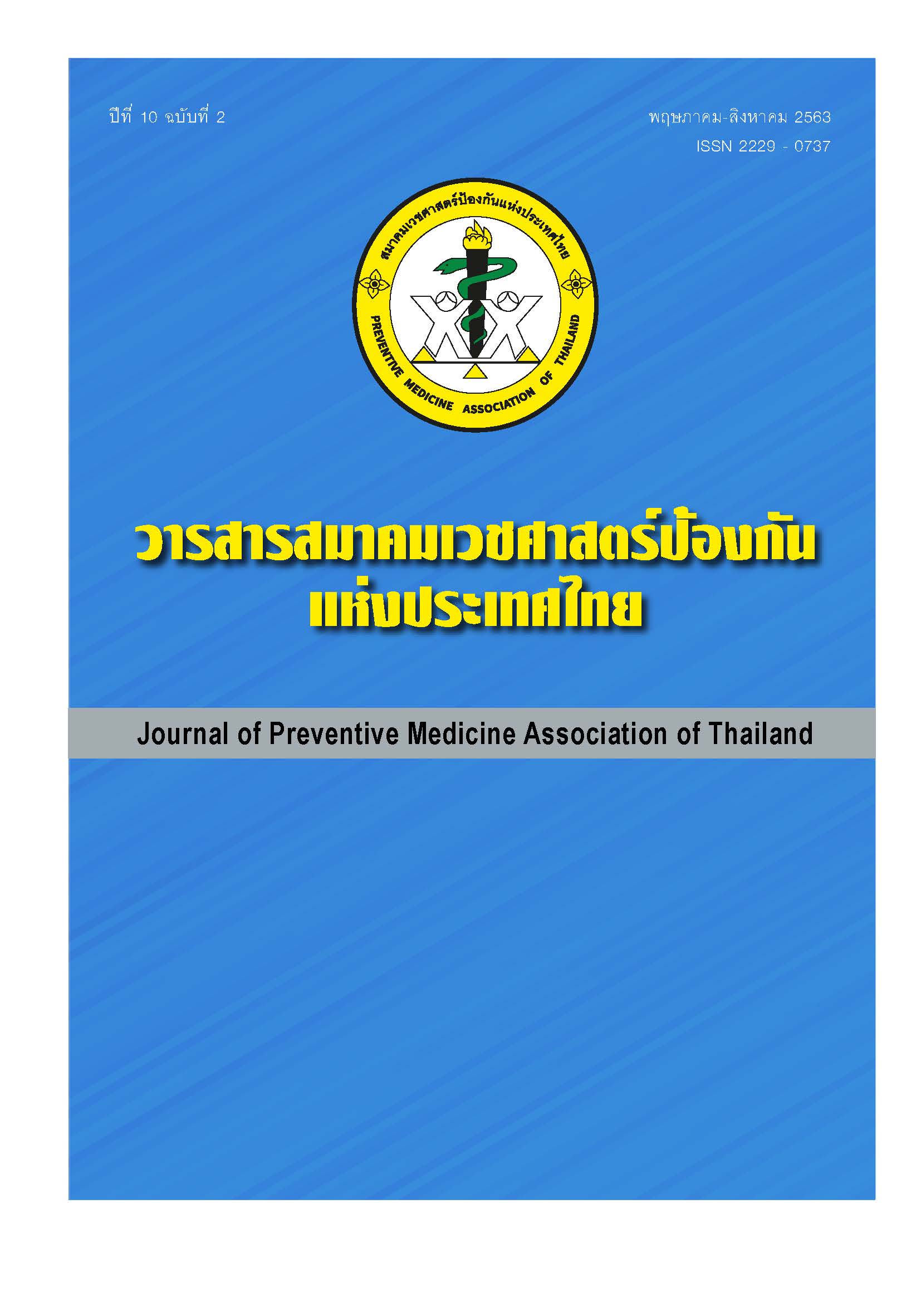Health Literate Community Model for Health Behavioral Changes in Diabetic and Hypertensive Patients in Wiang Sa District, Nan Province
Keywords:
Non-communicable disease, health literacy, health management communityAbstract
The incidence of diabetes mellitus and hypertensive patients have continuously increased due to varieties of risk factors involving lifestyle changes. However, these risk factors can be prevented by improving appropriate lifestyles and using a community-based approach. The purposes of this study were (1) to identify the health literacy situations of NCDs patients; (2) to develop a model of the health literacy community in order to change behaviors among NCDs patients; and (3) to evaluate the patient outcomes. The research and development method was conducted in 17 villages in 17 sub-districts of Wiang Sa District, Nan Province. The study consisted of 3 phases including analyzing the situation and assessing patient's health literacy for phase 1, developing the health literate model for NCDs patients in each community for phase 2; and evaluating the health literacy community model for phase 3. The study analyzed quantitative data using descriptive statistics as frequency, mean, percentage and t-test. In addition, this study also applied content analysis to analyze qualitative data. This one-year study was carried out from October 2018 to September 2019. The results showed that 60% of participants were female. The majority of patients (65%) were people at the age of 60 years or older. Approximately half of the participants (52%) were farmers. After six months of implementations the participants improved better health literacy scores such as knowledge of health promotion under the 3E2S principle, accessibility and the use of health information, verbal persuasion skills, planning and management of health behavioral changes, and the levels of health behavior of the 3E2S principle. These were found to be statistically significant (P<0.05). However, there were no statistically significant differences regarding understanding the 3E2S principle, the decision making involved to change behaviors such as eating, exercise, smoking and drinking. With respect to the health outcomes, the proportion of patients who have normal waistlines, normal blood pressure and regular blood sugar increased 10%, 4.6% and 0.2%, respectively. These were reported a statistically significant difference (p<0.05). However, there was no statistically significant difference for patients with a BMI of less than 25 kg/m2. The study suggested that the key success factors were having a community with a strong leadership which have an effective policy and communication skills, providing exercising areas for villagers, implementing effective public health policies, developing learning health literacy activities; using the 3E2S's daily logbook; using positive reinforcement; monitoring and home visiting. Therefore, this model of the health literate community should be implemented in other communities with adjustments made and activities included relevant to their area.
References
2. สำนักโรคไม่ติดต่อ กรมควบคุมโรค กระทรวงสาธารณสุข. คู่มือการดำเนินงานป้องกันควบคุมโรคไม่ติดต่อเรื้อรังโดยยึดชุมชนเป็นฐาน. นนทบุรี:กรมควบคุมโรค กระทรวงสาธารณสุข; 2560.
3. สภาขับเคลื่อนการปฏิรูปประเทศ. รายงานคณะกรรมาธิการขับเคลื่อนการปฏิรูปประเทศด้านสาธารณสุขและสิ่งแวดล้อม สภาขับเคลื่อนการปฏิรูปประเทศ เรื่อง การปฏิรูปความรอบรู้และการสื่อสารสุขภาพ. กรุงเทพฯ: สำนักงานเลขาธิการสภาผู้แทนราษฎร; 2559.
4. ธีรวุฒิ เอกะกุล. ระเบียบวิธีวิจัยทางพฤติกรรมศาสตรและสังคมศาสตร. อุบลราชธานี:สถาบันราชภัฏอุบลราชธานี; 2543.
5. กองสุขศึกษา กรมสนับสนุนบริการสุขภาพ. การประเมินความรอบรู้ด้านสุขภาพ (HEALTH LITERACY) ของประชาชนเรื่อง 3อ2ส. นนทบุรี:กระทรวงสาธารณสุข; 2557.
6. กิตติพศ วงศ์นิศานาถกุล. ความฉลาดทางสุขภาพของผู้ป่วยโรคเบาหวานที่เข้ารับบริการ ณ ศูนย์เวชปฏิบัติครอบครัว โรงพยาบาลพระนครศรีอยุธยา. วารสารสมาคมเวชศาสตร์ป้องกันแห่งประเทศไทย 2561;8:49-61.
7. อุทัย เจริญจิตต์. ผลของการใช้โปรแกรมส่งเสริมสุขภาพในผู้ป่วยโรคเบาหวานต่อความรอบรู้ด้านสุขภาพและพฤติกรรมสุขภาพตาม 3อ2ส ของผู้ป่วยโรคเบาหวาน ศูนย์สุขภาพชุมชนเมือง โรงพยาบาลบ้านโป่ง. วารสารหัวหินสุขใจไกลกังวล 256;3:58-72.
8. พงษ์ศิริ งามอัมพรนารา. ความรอบรู้ด้านสุขภาพของผู้ป่วยเบาหวานชนิดที่ 2 ในกรุงเทพมหานครและปริมณฑล. [วิทยานิพนธ์ปริญญาวิทยาศาสตรมหาบัณฑิต]. กรุงเทพฯ:จุฬาลงกรณ์มหาวิทยาลัย; 2560.
Downloads
Published
How to Cite
Issue
Section
License
บทความที่ลงพิมพ์ในวารสารเวชศาสตร์ป้องกันแห่งประเทศไทย ถือเป็นผลงานวิชาการ งานวิจัย วิเคราะห์ วิจารณ์ เป็นความเห็นส่วนตัวของผู้นิพนธ์ กองบรรณาธิการไม่จำเป็นต้องเห็นด้วยเสมอไปและผู้นิพนธ์จะต้องรับผิดชอบต่อบทความของตนเอง






